Sovereign Debt Crisis, America, PIIGS “R” Us too?
Interest-Rates / US Debt May 23, 2010 - 04:08 AM GMTBy: Michael_Pollaro
 The title of this essay may be a play on words but the facts are nothing of the sort. Indeed, the facts suggest that the financial position of the U.S. government may not be all that much better than the financial position of the governments of Portugal, Italy, Ireland, Greece or Spain, the so-called PIIGS. In fact, given the agenda the Obama administration has set for America, one so far distinguished by ever larger government spending programs being financed by ever larger amounts of debt, the U.S. government may be well on its way to becoming PIIGS “R” Us.
The title of this essay may be a play on words but the facts are nothing of the sort. Indeed, the facts suggest that the financial position of the U.S. government may not be all that much better than the financial position of the governments of Portugal, Italy, Ireland, Greece or Spain, the so-called PIIGS. In fact, given the agenda the Obama administration has set for America, one so far distinguished by ever larger government spending programs being financed by ever larger amounts of debt, the U.S. government may be well on its way to becoming PIIGS “R” Us.
Sensationalism this is not.
Food for thought for holders of U.S. Treasury bonds? You bet.
To see why, let’s start with a snapshot of the sovereign debt risk metrics of the U.S. government versus the PIIGS on fiscal year 2009 financials:
Sovereign Debt Risk Metrics
United States versus the PIIGS, Fiscal Year 2009
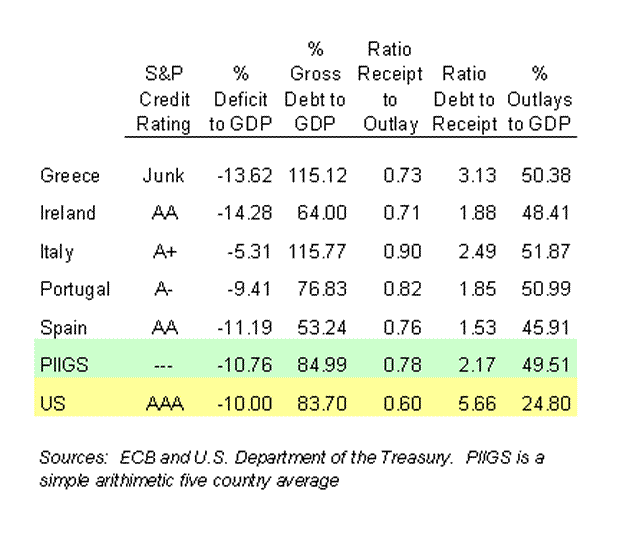
The PIIGS are looking at some huge financial imbalances, that much is for sure. But I ask you, do the debt risk metrics of the U.S. government look that much different? Is the debt of the U.S. government, as S&P’s triple-A credit rating suggests, that much more credit worthy than the debt of say Spain, Ireland or even Greece?
Let’s have a look at each risk metric, the way a sovereign debt investor might, ranking the countries on those metrics from “bad” to “worse.”
Economic Burden Metrics
The ability of a government to pay its bills ultimately comes down to the ability of its citizenry to produce income high enough to pay those bills. On this score, America is not a country that many would want to emulate, showing Deficit to GDP and Debt to GDP ratios no better than the average PIIG:
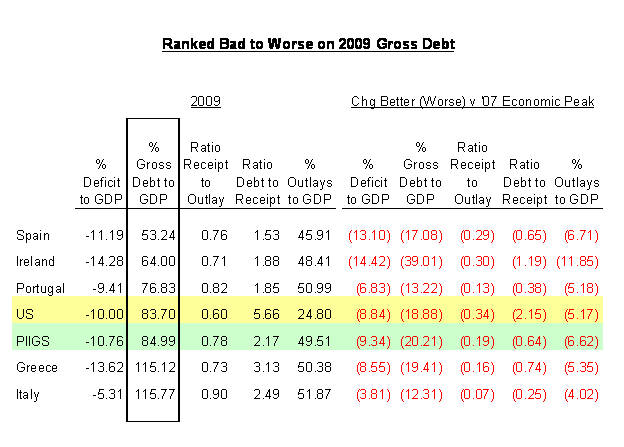
Coverage Ratio Metrics
Financial analysts measure an entity’s ability to pay its obligations in several ways. One popular way is through a metric known as a coverage ratio. In this sovereign risk study, I offer up two coverage ratios:
Receipts to Outlays, measuring a government’s ability to fund its spending needs via current tax receipts, with a ratio of less than one meaning that that spending is being financed by deferring the costs of that spending into the future via the issuance of debt, and
Gross Debt to Receipts, representing the number of years it will take a government to repay its debt obligations at its current level of tax receipts, debt obligations incurred as result of years of opting to finance its spending the easy way – via debt issuance instead of via current tax receipts.
On both these risk metrics, the U.S. is at the bottom of the list by a “country” mile:
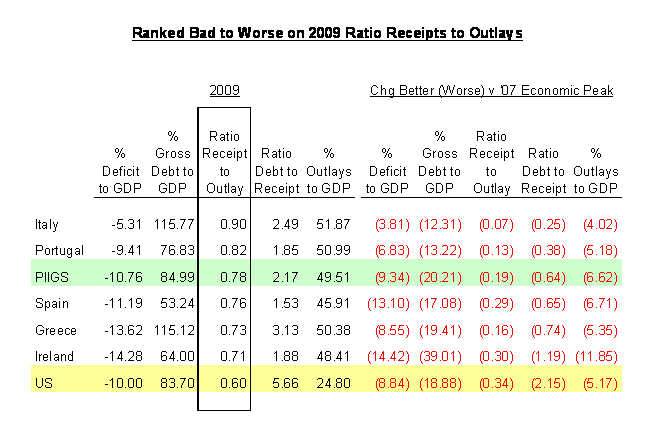
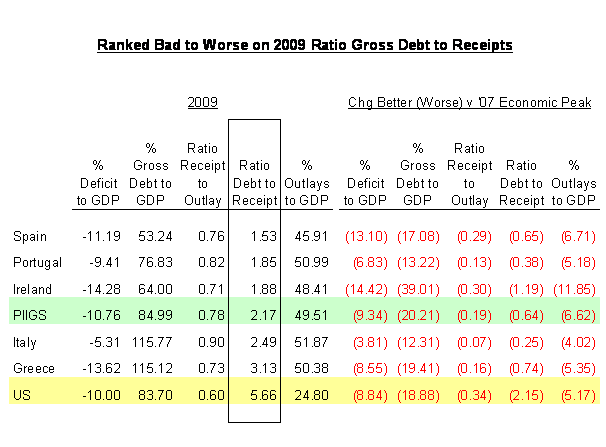
Size of Government
America has one big thing going for it – the size of its government relative to the size of its economy is, on a comparative basis, relatively small, taking some 25% of the economy versus the roughly 50% taken by the PIIGS. That implies that America’s ability to grow its income and pay its bills is better than that of the countries of the PIIGS. Have a look at the numbers:
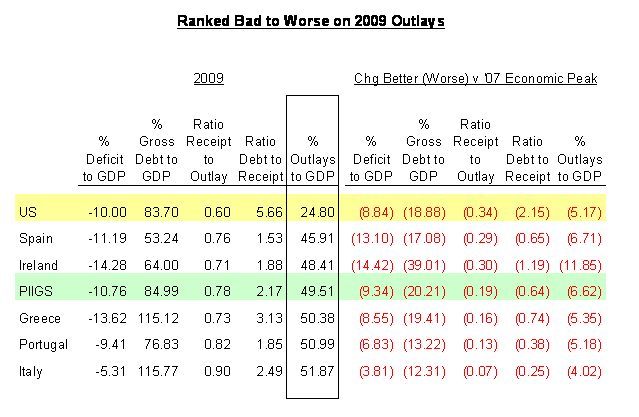
At first glance, and as a holder of U.S. Treasury bonds, perhaps this is reason for hope, and reason for that triple-A rating. But a deeper dive into the particulars suggests something quite different.
Since 2000, the U.S. government’s spending bill has been growing at an annual rate of about 8%, more than double the rate seen in the 1990s, and a trend that has taken government spending from about 18% of GDP in 2000 to today’s 25%. Add $100 trillion plus and counting in unfunded-liabilities-come-spending into the mix, as well as a host of economically debilitating tax rate hikes beginning as soon as 2011, and you have the makings of an economy that will be increasingly burdened by the government, making it harder and harder for the government to pay it’s bills. And may I say, all this without the U.S. Congress creating even one more government program.
Maybe not today’s problem, but looking forward, a bad omen for all holders of U.S. Treasury bonds, especially given the debt hole America has already dug for itself.
Debt Risk Metric Scorecard
Borrowing a tool used by baseball, let’s recap by constructing a Sovereign Debt Risk Scorecard. Again, going from bad to worse, America on this metric is near the bottom of the list:
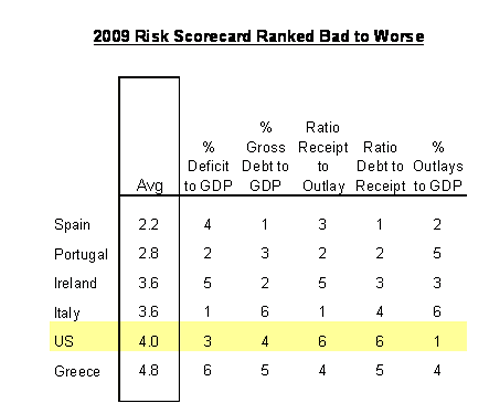
Granted, these are but a few summary metrics. Granted, the average risk metric so computed is a simple, unweighted arithmetic average. But if these numbers don’t make you think, think that America’s triple-A status may be a bit too “generous,” then may I suggest you could be guilty of not thinking. Not something I would recommend if you are, or plan to be an investor in U.S. government debt obligations.
IMF Looks Ahead and It Doesn’t Like What It Sees Either
In its April 20th 2010 Global Financial Stability Report, the International Monetary Fund (IMF) warned that government risk in the advanced economies is now the biggest threat to the world economy. These governments, the IMF correctly observes, not only took on many of the bad debts incurred by private institutions these past several years, but due to the economic fallout of the crisis, and the existence of a plethora of government social nets, these governments face continuing heavy borrowing needs for at least the next few years. An ugly situation for sure, and one the IMF said could get out of hand, and fast, if not addressed.
In conjunction with the release of the report, José Viñals, Financial Counselor and Director of the IMF’s Monetary and Capital Markets Department, said:
In spite of recent improvements in the outlook and the health of the global financial system, stability is not yet assured.… If the legacy of the present crisis and emerging sovereign risks are not addressed, we run the very real risk of undermining the recovery and extending the financial crisis into a new phase.
This author couldn’t have said it better.
Yet, in 2010, the U.S. Congress passed the largest government spending initiative in history in Obamacare. Now, those same politicians are talking about cap and trade, not to mention even more stimulus programs. This on top of those already horrible 2009 debt risk metrics.
Clearly, America is not addressing the seriousness of its financial state.
Indeed, the IMF put pen to paper, suggesting the very same thing about America. This, taken from the IMF’s World Economic Outlook Database:
America, on the basis of these metrics says the IMF, is a nation going in the wrong direction. With an estimated Deficit to GDP ratio of 10.97% in 2010, only Ireland is expected to show a ratio worse than the U.S.
America is NOT a PIIG?
Surely, you say, America is not a Greece, an Ireland or even a Spain. And in a sense you would be correct. Just not in the way you think. For in one very important respect, America is potentially worse, a lot worse.
You see, America has the Federal Reserve’s printing press. Steward of the world’s reserve currency, America issues debt in a currency it alone can print. America can in no uncertain terms inflate its debt away, without limitation, with a few taps on a computer.
Portugal, Italy, Ireland, Greece and Spain, members of the Euro-zone are countries without a printing press. They can’t bail themselves out by printing money to pay for their debts. No, as we are witnessing in this, the latest financial crisis, they have to show at least some manner of fiscal austerity before they can get access to the printing press of the European Central Bank.
Can the same be said about America?
In essence, the Federal Reserve’s printing press is buying time for America. It allows America to kick the debt-can down the road a bit longer, no holes barred, an option not available to the PIIGS. The result, the appearance that America is in control, its finances manageable, nothing at all like the finances of the PIIGS.
The problem is that same printing press eventually makes matters worse, because it fosters even more irresponsibility on the part of politicians, allowing them to hand out economic goodies without thought, without ever having to ask a single voter to pay for them. And as a result, the debt-can gets ever bigger, while the urge to inflate it away gets ever stronger.
Isn’t this exactly what we say happening in America, right now?
One day this debt-can, and perhaps by that time the mother of all cans, will have to be paid in full. The only question will be whether that payment will be via fiscal austerity or via the debasement of the currency in which that can is priced.
One thing is for sure. If you want to wreck a country’s economy, and its sovereign credit risk to boot, you do it with a printing press. And if it comes to this, you can be equally sure that U.S. Treasury bond investors will be all over it, because at that point it will be clear to all that the last investor out is going to be an investor holding a can with nothing in it but worthless pieces of paper.
Final Thoughts
Right now, U.S. Treasury bonds are in rally mode, as aghast over the crisis in Europe is chasing both hot and scared money into the U.S. Treasury market. The reason, the U.S., home to the largest government fixed income market in the world and owner of the world’s reserve currency, is still viewed by many as the safe haven of choice. At the very least, the best of the worst, on the the belief that America will not go down, at least not yet.
And you know what, as negative as this author is on America’s sovereign credit, that assessment is largely correct, for now.
In my book, and I think in the books of a growing number of U.S. Treasury bond investors the world over, it’s rent-a-bond not buy-a-bond when it comes to Americas sovereign debt. Indeed, for the reasons discussed in this essay, and explored in depth in this series, America’s increasingly ugly sovereign risk metrics will not go unnoticed forever. They can’t, for the path America is on is simply unsustainable. If America does not heed the advice of the IMF, it may one day end up just like Greece.
U.S. Treasury bond holders will see to it.
A full accounting of the U.S. government’s financial condition, updated monthly courtesy of THE CONTRARIAN TAKE, can be found here.
By Michael Pollaro
Michael Pollaro writes a column called THE CONTRAIAN TAKE at True / Slant.com, its mission statement to present thoughts and ideas on important financial market and economic trends from the perspective of a free-market, Austrian economist.
Michael Pollaro is a retired Investment Banking professional, most recently Chief Operating Officer for the Bank's Cash Equity Trading Division. He is a passionate free market economist in the Austrian School tradition, a great admirer of the US founding fathers Thomas Jefferson and James Madison and a private investor.
Website: http://trueslant.com/michaelpollaro/ Email: jmpollaro@optonline.net
Copyright © 2010 Michael Pollaro - All Rights Reserved Disclaimer: The above is a matter of opinion provided for general information purposes only and is not intended as investment advice. Information and analysis above are derived from sources and utilising methods believed to be reliable, but we cannot accept responsibility for any losses you may incur as a result of this analysis. Individuals should consult with their personal financial advisors.
© 2005-2022 http://www.MarketOracle.co.uk - The Market Oracle is a FREE Daily Financial Markets Analysis & Forecasting online publication.




